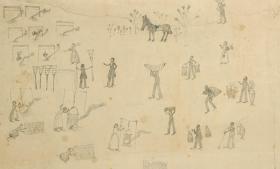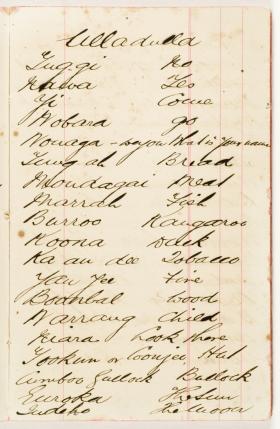The world of Mickey of Ulladulla
Students investigate the impact of settlement on Aboriginal peoples by examining the artworks of Mickey of Ulladulla and a Dhurga word list.
Student Activities
Mickey of Ulladulla
Students examine a scene of Aboriginal life as drawn by Mickey of Ulladulla and identify items within the source.

Aboriginal (Dhurga) word list
Students sorts words from an Aboriginal (Dhurga) word list to investigate the impact of settlement on Aboriginal peoples.

NSW Syllabus for the Australian Curriculum History K - 10
HT3-1 describes and explains the significance of people, groups, places and events to the development of Australia
HT3-2 describes and explains different experiences of people living in Australia over time
HT3-5 applies a variety of skills of historical inquiry and communication
The nature of convict or colonial presence, including the factors that influenced patterns of development, aspects of the daily life of inhabitants (including Aboriginal and Torres Strait Islander peoples) and how the environment changed(ACHHK094)
Students:
- outline settlement patterns in the nineteenth century and the factors which influenced them
- discuss the impact of settlement on local Aboriginal peoples and the environment
- discuss the diverse relationships between Aboriginal peoples and the British
- investigate the everyday life of a variety of men and women in post-1800 colonial settlements using a range of sources and explain their different experiences
Comprehrension: chronology, terms and concepts
- sequence familiar people and events (ACHHS065, ACHHS081)
- use historical terms (ACHHS066, ACHHS082)
Analysis and use of resources
- locate relevant information from sources provided (ACHHS068, ACHHS084, ACHHS215, ACHHS216)
Perspectives and interpretations
- identify different points of view within an historical context (ACHHS069, ACHHS085)
Research
- pose a range of questions about the past (ACHHS067, ACHHS083)
Explanation and communication
- develop texts, particularly narratives (ACHHS070, ACHHS086)
- use a range of communication forms (oral, graphic, written) and digital technologies (ACHHS071, ACHHS087)
Significance: importance of an event, development or individual/group
Perspectives: people from the past will have different views and experiences
Learning across the curriculum
- Aboriginal and Torres Strait Islander histories and cultures
- Critical and creative thinking
- Intercultural understanding
What is the nature of the contribution made by different groups and individuals in the community?
Activity notes for teachers
Mickey of Ulladulla
Location list
| Mickey | The man holding the broom for sale is probably Mickey. He was disabled and needed sticks (held in one hand in this picture) to help him walk. |
| Kangaroo | There are about seven kangaroos. The three smaller ones amongst the trees in the upper left of the drawing are thought to be wallabies. |
| Wallaby | Smaller than kangaroos (among trees on the left) |
| Lyre bird | (Right) has a large coloured tail. |
| Echidna | Two (top centre and right) with spiky backs. |
| Koala | Has big ears and is in the tree on the left. |
| Goanna | One is middle right and the other is climbing a tree (middle, top) |
| Possum | Has a curly tail and is in the tree on the right. |
| Snake | On the ground below two kangaroos (top left) |
| Horse | Middle left and wearing a saddle and bridle - does it belong to the Europeans? |
| Dog | In the centre of the drawing below the house. |
| Men fishing | You can see the fishing lines and hooks hanging from the boat. The man on the right is hooking the shark into the boat and the man on the left is beating it with a stick. |
| Different types of fish | Mickey has drawn different kinds of fish in the water. It's difficult to tell how many different types, but Mickey shows that they are a variety of fish. This indicates that he must have had good knowledge of the range of fish in the area. |
| Sharks | Two sharks are visible, one in the water and the other is being drawn up into the boat. |
| Objects introduced by the Europeans | The house and the boat. You can tell the boat is not a native canoe because it has a rudder on one end. The boat was given to the Aboriginal people by the Aboriginal Protection Board. There are also pots, brooms, a saddle on the horse etc. |
Information for teachers:
Note: This activity is more challenging. It requires students to use higher order thinking to cross-reference information in Source B with objects they have identified in Source A.
| Aboriginal word | Australian English word | Information for teachers |
|---|---|---|
| tuggi | no | |
| nawa | yes | |
| ji | come | |
| nobard | go | |
| nonaga-weyou | What is your name? | |
| tewg-ah | bread | Could describe European bread |
| mondagai | meat | |
| marrah | fish | Write the Aboriginal word on drawing |
| burroo | kangaroo | Write the Aboriginal word on drawing |
| koona | duck | Ducks could be introduced by Europeans or native |
| ka au dee | tobacco | Introduced by Europeans |
| yau yee | fire | Write the Aboriginal word on drawing |
| boanbal | wood | |
| warrang | child | |
| niara | look there | |
| yookun or coonjee | hut | Could describe Aboriginal hut or European hut |
| cumboo gullock | bullock | Introduced by Europeans |
| Euroka | The sun | |
| Indeko | The moon |